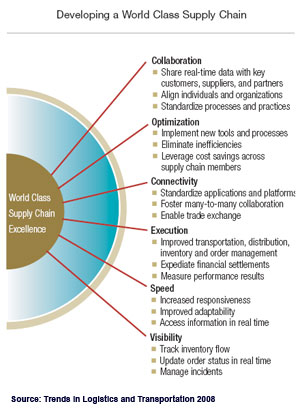SCDigest
Editorial Staff
| SCDigest Says: |
 But just what provides better visibility? Is it technology and systems integration? Or is it just as much a culture and mindset that may in some cases use more manual support systems but nonetheless improve decision-making? But just what provides better visibility? Is it technology and systems integration? Or is it just as much a culture and mindset that may in some cases use more manual support systems but nonetheless improve decision-making?

Click Here to See Reader Feedback
|
At the recent CSCMP 2008 conference in Denver, Dr. Karl Manrodt of Georgia Southern and Dr. Mary Holcomb of the University of Tennessee presented results from the 17th annual Trends and Issues in Logistics and Transportation report, which summarizes a survey of over 1000 supply chain professionals.
As we noted last week, one key finding of the data analysis was that larger firms seem to be gaining a competitive edge in supply chain performance, which the authors say may be largely related to greater investments in technology and integration. (See What Makes a Company a “Master of Logistics?”) This week, we summarize additional findings from the study.
For the past several years, the report's authors have presented a framework for supply chain excellence that includes six dimensions of performance: Collaboration, Optimization, Connectivity, Execution, Speed and Visibility (see graphic nearby).
 The authors say that they continue to find “that many firms are still struggling to implement these six drivers, and are therefore unable to achieve the transformation that is needed to move their organization forward.” The authors say that they continue to find “that many firms are still struggling to implement these six drivers, and are therefore unable to achieve the transformation that is needed to move their organization forward.”
The research also showed the competitive pressures that companies are facing. Picking up on the book “The Discipline of Market Leaders,” by Michael Treacy, the survey for several years has asked respondents to identify their primary competitive strategy: cost leadership, product innovation, customer service, or trying to be great at all three.
This year, the number of companies saying that their strategy was to be great at all three, or being “all things to all people,” rose 22% for a total of 45% of all respondents. That’s up from just 20% in 2004.
While Treacy’s book argued companies need to pick one primary strategy and just be good enough in the other two areas, it appears the tremendous level of global competition is causing more companies to believe that they can’t afford not to strive to be leaders in cost, service and innovation.
At the same time, while the cost leadership strategy had been losing numbers every year since 2004, it jumped markedly in this year's study, being cited by 17% of respondents versus just 8.4% in 2007. Will this strategy hold? The report says that “It is anticipated that this shift in strategic direction will be the new reality as long as the current economic conditions persist.”
(Supply Chain Trends and Issues Article - Continued Below)
|